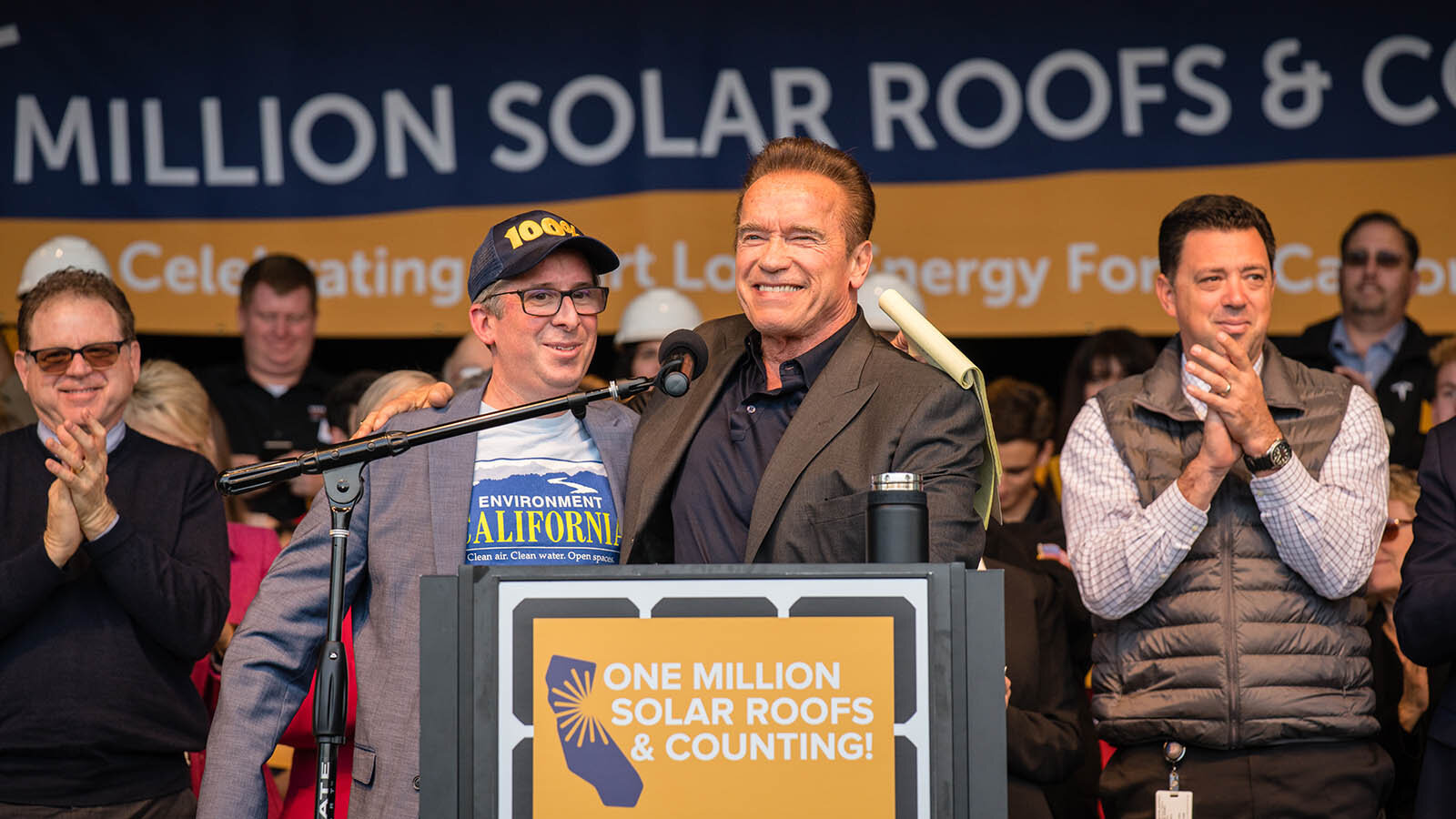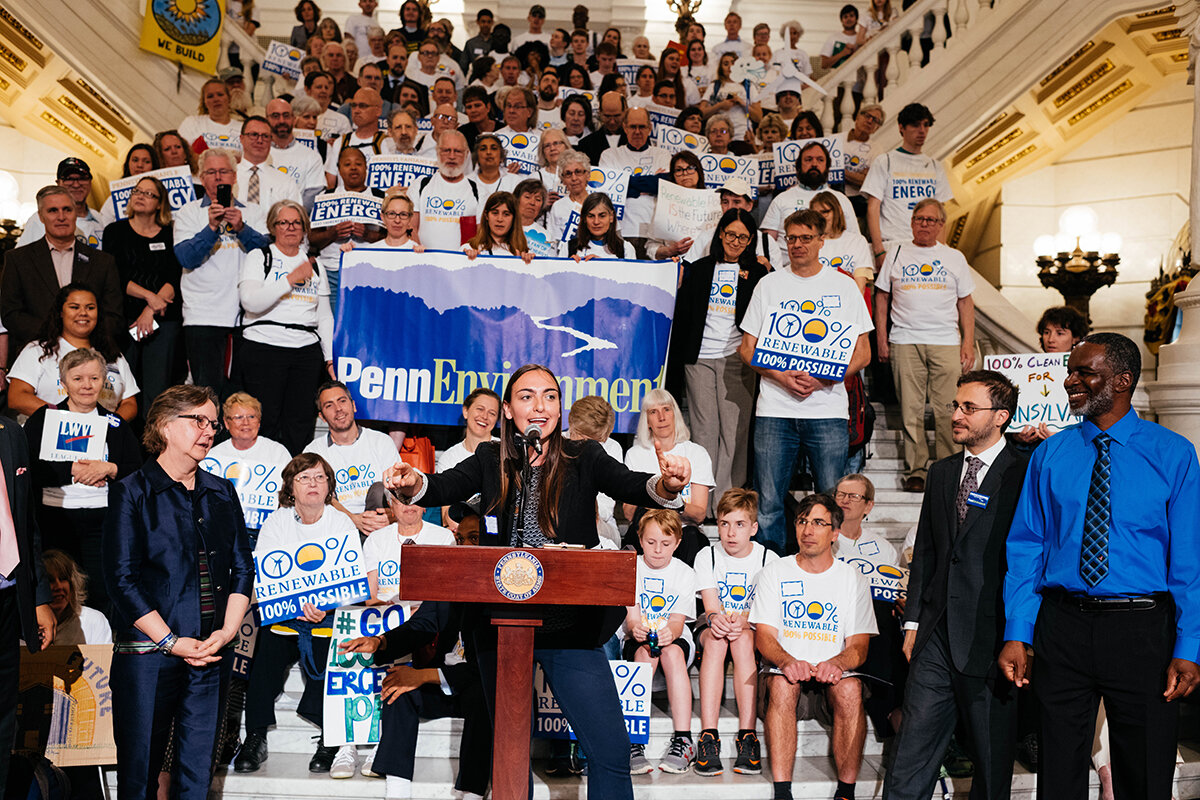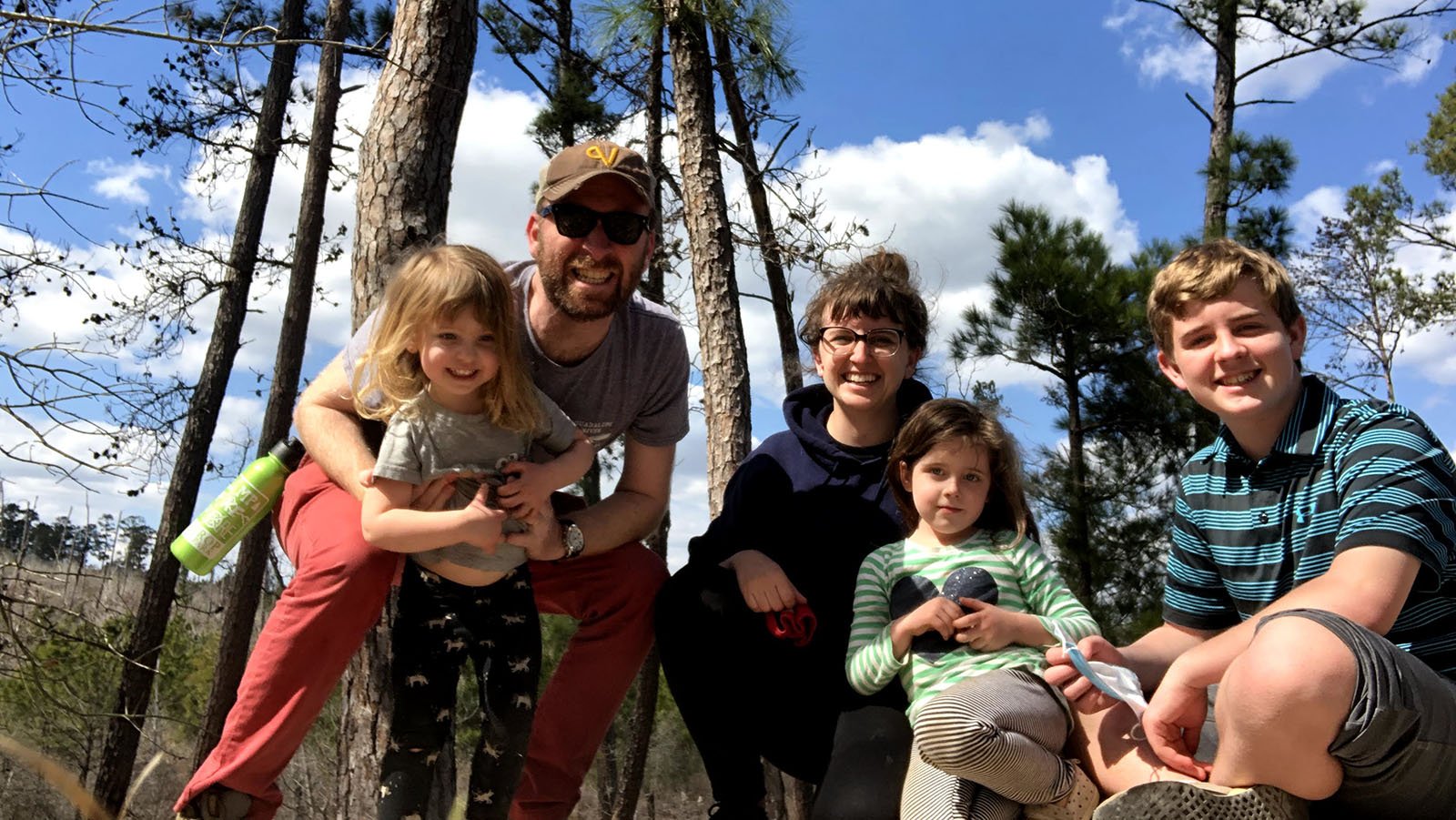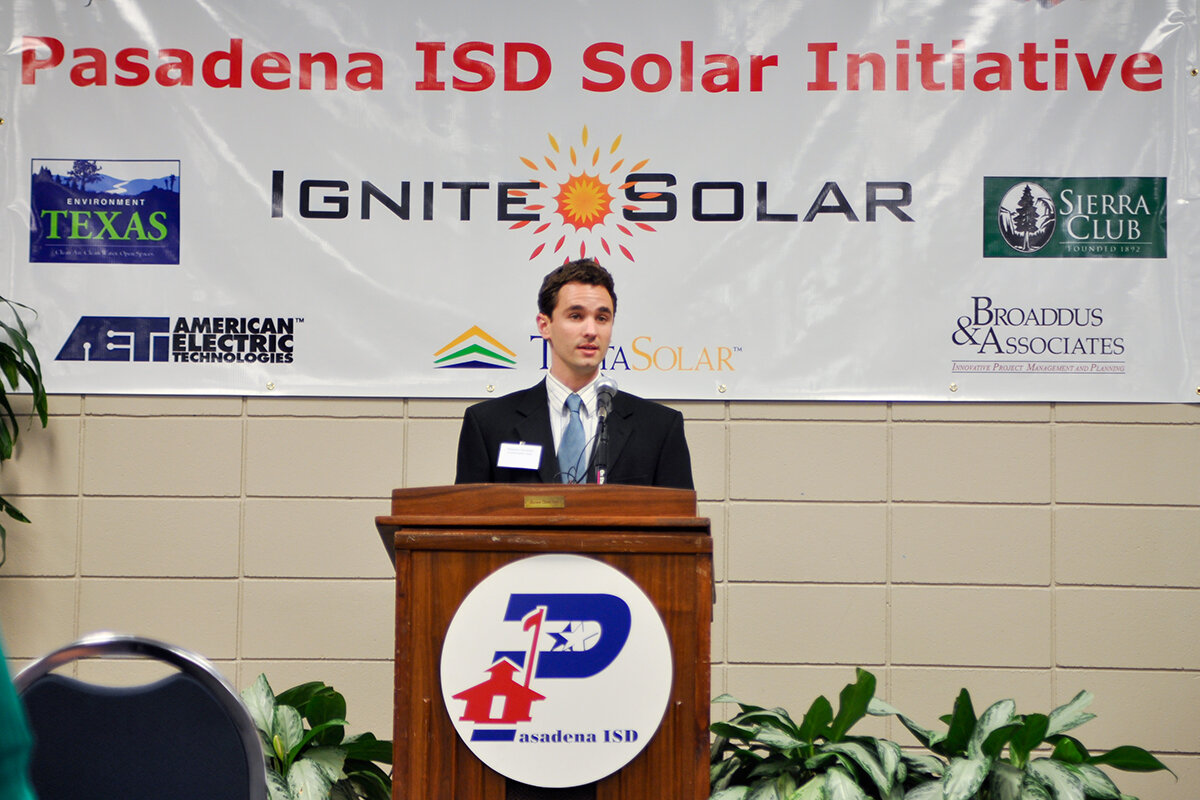
The laboratories of democracy
Four milestones in state-level action and advocacy
A single courageous state… or two, or three, or...
In 1932, U.S. Supreme Court Justice Louis Brandeis observed that a strength of the American political system is that "a single courageous State may, if its citizens choose, serve as a laboratory; and try novel social and economic experiments without risk to the rest of the country.”
Since the first state PIRG sprung up in Oregon, our network has taken this premise to heart, crafting and advancing solutions to social problems in America’s laboratories of democracy.
This state-focused model has kept the PIRGs (and starting in 2002 in Pennsylvania, our state environmental groups) close to the people on whose behalf we advocate. And it has allowed us a firmer grasp on both the problems that most directly affect their wellbeing and the solutions that can make the most tangible difference in their lives.
Our nationwide reach

A model that facilitates action for a change
Today, led by Senior Director for State Organizations Emily Rusch, our state team includes PIRGs in 24 states, state environmental groups (affiliated with Environment America) in 30 states, and a deep roster of more than a dozen state directors and advocates with 10 or more years of professional public interest experience.
Together, this team has built a culture and structure that fosters a nationwide sharing of information and ideas — thereby spreading sensible, often innovative solutions to social problems more rapidly from state to state or, as in the case of policies from toxic waste cleanup initiatives to Clean Car Standards, to the federal level.
Here’s a look at this work in four states: Massachusetts, California, Pennsylvania and Texas. Each state comes with its own challenges, as well as its own political, cultural, social and economic identity.
Our state directors and advocates, by combining their knowledge of local problems, politics and people with a vast and growing suite of policy ideas and campaigns gathered from across the country, keep finding ways to win concrete results that make people’s lives a little healthier, safer and greener, in their own states and across the country.
Video credit: Boston, Mass.: Hangtime Media, Harrisburg, Penn: BlackBoxGuild, Sacramento: Cal.: Epic Flight Films, Austin, TX: Vinnie Fallico. All via Shutterstock.
About this series: PIRG and The Public Interest Network have achieved much more than we can cover on this page. You can find more milestones here.

Change comes to MASSPIRG
As 1980 came to a close, the political climate for MASSPIRG’s work appeared to be inhospitable at best. A pro-business, socially conservative Democrat, Ed King, was governor. Nationally, Ronald Reagan had upset Jimmy Carter — even in liberal Massachusetts. Other state PIRGs created in the 1970s had become diminished in size and influence. Some had even shut down.
But change was coming. Under the leadership of Doug Phelps, who became MASSPIRG’s executive director in 1979, Program Director Mindy Lubber and Organizing Director Susan Birmingham, MASSPIRG revitalized its college campus chapters and started a door-to-door citizen outreach canvass.
With a stronger base of student and citizen action and support, MASSPIRG over the next decade won more than a dozen policy victories that made a difference in people’s lives and established the group as a positive force in state politics. Here are three of these stories.
The Bottle Bill
In 1981, MASSPIRG entered the home stretch of what turned out to be a nine-year campaign to win a Bottle Bill in Massachusetts.
Bottle Bills, which require consumers to pay redeemable deposits on beverage containers to encourage their return to stores and redemption centers, had proven successful in cleaning up litter and promoting recycling in Oregon, Vermont and other states. Yet Massachusetts lawmakers kept siding with the beverage and grocery industries that opposed the idea.
But by the 1981 state legislative session, thanks to MASSPIRG’s new campus organizers and citizen outreach canvass, the group was informing hundreds of thousands of people, face to face, about the Bottle Bill. Pro-Bottle Bill calls and letters poured into the offices of Gov. King and state legislators (with the deluge of calls driving one of the governor’s telephone operators to threaten to quit in frustration).
The calls and letters, along with dozens of town hall meetings, made the difference. In November 1981, legislators voted to override the governor’s veto. In 1982, when industry groups put a Bottle Bill repeal question on the ballot, thousands of citizen volunteers distributed literature and covered the polls on Election Day, ensuring a 59-41% victory.
The Hazardous Waste Cleanup Initiative
In the fall of 1985, MASSPIRG’s increasingly potent grassroots team gathered signatures from 129,000 registered voters, more than enough to qualify for the ballot an ambitious plan to clean up thousands of hazardous waste sites.
In November 1986, state voters approved the Hazardous Waste Cleanup Initiative, crafted by MASSPIRG’s Bill Ryan, with a record 74% yes vote. To encourage the thousands of volunteers on the campaign to stay involved in local environmental campaigns, MASSPIRG’s Citizen Lobby created a new organization: the Massachusetts Campaign to Clean Up Hazardous Waste.
That organization, renamed Community Action Works, still exists today as part of The Public Interest Network.
The Toxics Use Reduction Act
After the approval of the ambitious toxic cleanup initiative, MASSPIRG turned our attention to pollution prevention. Bill Ryan helped craft a bill that would require industries to reduce their use of toxic chemicals.
Aware that MASSPIRG could bring a more restrictive variation of the policy to the ballot, the Associated Industries of Massachusetts agreed to a compromise version with lawmakers and MASSPIRG’s Margie Alt. Gov. Mike Dukakis signed the Toxics Use Reduction Act into law on July 24, 1989.
The law not only reduced toxic emissions, but it also led to the creation of the Toxics Use Reduction Institute at the University of Massachusetts at Lowell and has been recognized as an innovative and effective model for state environmental policy.

Mindy Lubber (MASSPIRG Lobbyist) and Doug Phelps promote Bottle Bill, 1981. Photo by staff

Margie Alt (MASSPIRG Toxics Advocate) speaks at signing of Toxics Use Reduction law with Governor Dukakis. Photo by staff

The work started in the 1986 Campaign to Clean Up Hazardous Waste developed into the current organization Community Action Works. Here, a community group working with Community Action Works demonstrates opposition to a proposed pipeline in Pepperell, Massachusetts in August 2014. Photo by Stephanie Pierce

California makes waves
With nearly 40 million people and the world’s fifth-largest economy, California’s influence is unmatched among American states.
That’s why the impact of CALPIRG, CALPIRG Students and Environment California has often rippled beyond the state’s borders, on consumer protection, clean energy, ocean conservation, global warming, plastic pollution and more. Built by Jerry Skomer, Deb Bruns, Susan Birmingham, Bob Shireman, Lucinda Sikes, Mary Raftery, Andre Delattre, Dan Jacobson, Emily Rusch, Bernadette Del Chiaro and many others over the years, the organizations have repeatedly advanced trail-blazing policies that have improved the quality of life for Californians, as well as millions of other Americans.
Sparking the automotive transition
California’s congressional waiver to set stricter auto emission limits than federal standards predates CALPIRG. Yet the organization has played a key role in strengthening the limits and the PIRG network has helped export them across the nation.
For example, after California created the country’s first Zero Emission Vehicle (ZEV) standards, Mary Raftery and CALPIRG were instrumental in defending the program against an auto industry attempt to roll them back in 1994.
Ten years later, our staff and volunteers gathered 100,000 petition signatures to help pass a bill that, for the first time, targeted global warming pollution from motor vehicles -- a historic victory for our climate.
Meanwhile, PIRGs in other states took up the cause. MASSPIRG convinced the Bay State to adopt California’s ZEV program in 1990; NJPIRG persuaded New Jersey to follow suit in 2004. Today, 13 states in all, plus Washington, D.C., have adopted the rules, representing a quarter of all Americans. A nationwide transition to electric vehicles is increasingly seen as inevitable.
The energy transformation gains power
California also has been a leader in setting, and then achieving, increasingly ambitious goals for solar- and wind-generated electricity.
In 2018, the state set a new high-water mark with a commitment to 100% zero-carbon electricity by 2045. Led by Dan Jacobson, Environment California, CALPIRG and CALPIRG Students advocated and organized for the bill, which Gov. Jerry Brown signed into law on Sept. 10, 2018.
Once again, California’s movement made waves beyond its borders, with help from our staff and supporters. By the end of 2019, New Mexico and Washington state passed their own 100% clean energy laws after campaigns waged by our advocates. As of August 2021, eight states had committed to a goal of 100% clean electricity.
Colleges embrace clean energy
A key ingredient in our network’s recipe for success in California is CALPIRG Students, the PIRG college chapter organization. Tapping the expertise and other resources of their campuses, students have brought youthful vision, energy and enthusiasm to multiple campaigns, including clean energy.
Under the leadership of Jenn Engstrom and Kat Lockwood, in 2018 CALPIRG Students helped win a landmark commitment from the entire University of California (UC) system to run all 10 of its campuses on clean, renewable electricity by 2025.
The Student PIRGs organized thousands of students and dozens of faculty members to call on their schools to make the commitment. As David Phillips, an associate UC vice president, said: “UC’s system-wide commitment to carbon neutrality and sustainability originated from students asking the University to practice what it teaches.”
The UC system is spread over 10 campuses, enrolls nearly 300,000 students, and is perhaps the nation’s most prestigious such system. What the UC schools do has nationwide influence. After the UC commitment to 100% renewable energy, dozens of colleges and universities followed their lead.
Entering the 2021-22 academic year, the Student PIRGs had set a goal of winning similar commitments at 150 schools.
Photo credit: Thomas Ovalle

CALPIRG’s Mary Raftery. Photo by staff

Gov. Brown signs the law committing California to 100% clean electricity as CALPIRG Director Emily Rusch and Environment California Director Dan Jacobson look on. Photo by Joe McHugh, California Highway Patrol

Students have been at the forefront of social change for decades, and college campuses are perfectly positioned to lead the way to a renewable energy future. Photo by Giselle Turner

A voice for the environment in coal country
Years before Ben Franklin and friends gathered in what we now call Independence Hall, a Pennsylvanian blacksmith began using local coal to heat his forge, sparking the state’s long relationship with fossil fuels.
By the mid-1850s, the Keystone State had become “King Coal”, with its economic future fused to coal-powered energy. As our nation’s dependence on coal, oil and gas soared, so did Pennsylvania’s production of these fuels, rising like fumes from a smokestack, pronounced but impermanent — even as the scars of coal, and later, gas, extraction dug deep into the Pennsylvania landscape, soot and smog clouded the state’s skies, and the global climate began to warm.
This was the historical backdrop for the 2002 founding of PennEnvironment, a new home of PennPIRG’s environmental work and the first state environmental group in The Public Interest Network. David Masur, a veteran of the network since 1994, has been PennEnvironment’s executive director since the beginning and has built it into a strong and influential statewide organization.
Over the years, PennEnvironment has addressed a wide gamut of issues, from open space protection to removing the threat of lead in drinking water systems in schools. The organization’s signature campaigns, however, have taken direct aim at winning Pennsylvania’s independence from its fossil fuel-dependent past.
Citizens Lobby Days amplify voices for climate action
Since 2011 each June PennEnvironment has organized a Citizens Lobby Day in the state's capitol, Harrisburg.
Led at first by PennEnvironment’s Adam Garber and more recently by Flora Cardoni, the events have attracted hundreds of participants, lobbying their lawmakers for tougher action against fracking pollution and stronger support for clean energy. The Lobby Days have also earned increasing attention from state lawmakers. In fact in 2019, state senators had to close the doors to their chamber just to tune out the chants and cheers of our supporters in the nearby Capitol rotunda.
When the pandemic struck in 2020, PennEnvironment had to regroup. On June 16, Flora and the rest of the team held the first virtual Citizens Lobby Day, with even greater participation: Nearly 450 members and activists took part in almost 100 meetings with state representatives and senators, calling on them to support electric vehicles, regional climate action and a state commitment to 100% clean energy.
Shifting the center of debate
PennEnvironment’s grassroots outreach and support have helped shift the center of debate on these and other environmental issues.
The organization has partnered with Sen. Bob Casey, a Democrat, as well as Rep. Brian Fitzpatrick, a Republican, on several federal environmental initiatives. While a ban or even limits on fracking remain controversial in Pennsylvania, PennEnvironment has won bipartisan support for our 100% Renewable Energy bill.
Pennsylvania, like the rest of the country, remains too dependent on fossil fuels, a dependence deepened by the state’s long history of oil, coal and gas production. But thanks in part to David Masur and the PennEnvironment team, the state is showing signs of slowly, but steadily declaring its independence.

PennEnvironment’s Flora Cardoni and PennEnvironment’s Adam Garber (second from right), along with Pennsylvania state legislators, advocated for legislation that would tackle climate change at the state capitol. Photo by Garen Meguerian

PennEnvironment’s David Masur testified to oppose hydraulic fracturing in the Marcellus Shale in October 2010. Photo by staff

PennEnvironment’s David Masur shakes hands with Rep. Chris Rabb as Pennsylvania legislators look on at the introduction of Pennsylvania’s 100% Clean Energy Bill in May 2019. Photo by PA Legislature

When they say everything is bigger in Texas, they most often mean ranches, football stadiums and honky tonk bars.
Environment Texas is redefining what bigger means, to Texans and others. It can also mean Big Bend National Park, which, at 801,163 acres, is big enough to encompass the state of Rhode Island. Or it can mean the 11,247 streams in Texas, which if you straightened them out and laid them end to end, would circle the Earth three times over. Or it can mean the wind in Texas, which blows hard and frequently enough to put four of the state’s cities on the list of the country’s Top 10 windiest.
For more than 20 years, first with TexPIRG and then with Environment Texas, Luke Metzger has built a staff and team of supporters to preserve the state’s open spaces, protect its rivers and streams, and harness its expansive renewable energy resources.
Of course, Texas also looms large when it comes to oil production, carbon dioxide emissions, and unlawful pollution. Luke and his team have taken the challenge by the (ahem) horns.
Holding some of the nation’s largest polluters accountable
Since 2015, Texas has seen a 155% uptick in unauthorized air pollution, including chemicals linked to asthma, cancer and reproductive issues. On every single day in 2019, industrial facilities illegally polluted the state’s air.
That’s why Environment Texas established the Texas Clean Air Project: to hold accountable polluters, especially those that willingly and repeatedly violate the law.
In citizen suits filed under provisions of the federal Clean Air Act, our attorneys have settled cases with Shell and Chevron Phillips. Under terms of the settlements, both companies agreed to reduce their toxic air emissions and pay nearly $8 million in penalties. In another clean air case, a judge imposed a $14 million penalty on ExxonMobil for 3,000 violations at the company’s Baytown facilities — a Texas-sized judgment that happens to be the largest such penalty in U.S. history. (ExxonMobil has appealed the decision and the case is ongoing.)
These cases have earned Environment Texas a reputation, according to the Houston Chronicle, as the “toughest enforcer of clean-air laws in Texas.”
A big impact across multiple issues
Environment Texas has had a big impact on other environmental issues across the state as well:
On open space: In 2008, Environment Texas advocacy and the actions of more than 10,000 of our supporters helped block the sale to private interests of the Christmas Mountains, a spectacular spot next to Big Bend National Park. The group has helped expand Texas parks and their safeguards since then, including the 2021 protection of undeveloped land near Guadalupe River State Park. Environment Texas is now calling for protection for 1 million acres of new parkland.
On clean water: In 2006, Luke and his team successfully urged the Austin City Council to restore funds for protecting Barton Springs and the Edwards Aquifer. In 2021, Environment Texas Research & Policy Center identified unsafe levels of fecal bacteria (which is as gross as it sounds) at 55 of 61 beaches tested.
On clean energy: Our annual “Shining Cities” report has spotlighted the state’s best cities for solar power. In 2021, our researchers rebutted claims that wind and solar were to blame for the state’s catastrophic power outages during that winter’s deep freeze. The research helped defeat a bill that would have rolled back state support for renewable energy. Environment Texas group is now building support for a 100% renewable energy future for the state.
Sometimes, small is beautiful, even in Texas. But when it comes to clean air and water, clean energy, and open spaces, Environment Texas keeps working to convince the Lone Star State to think bigger.

Environment Texas' Luke Metzger, speaks at at event to announce measures to preserve the Christmas Mountains in Texas. Photo by Richard Whittaker

In November 2006, Austin voters approved $50 million to protect land in the Barton Springs watershed. Environment Texas contacted 20,000 voters before the vote to ensure its passage. Trong Nguyen via Shutterstock

Environment Texas clean energy advocate Alejandro Savransky attended the ribbon-cutting ceremony at Sam Rayburn High School in 2011, where Pasadena ISD installed the largest-up-to-that-point solar rooftop project on a public school in the state of Texas. Photo by Photo Denbow


